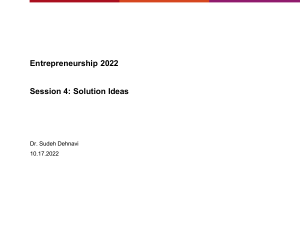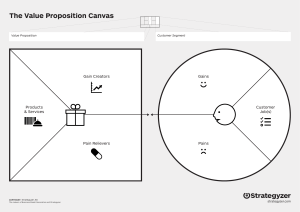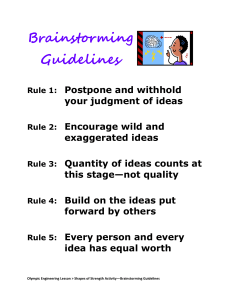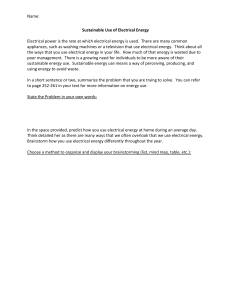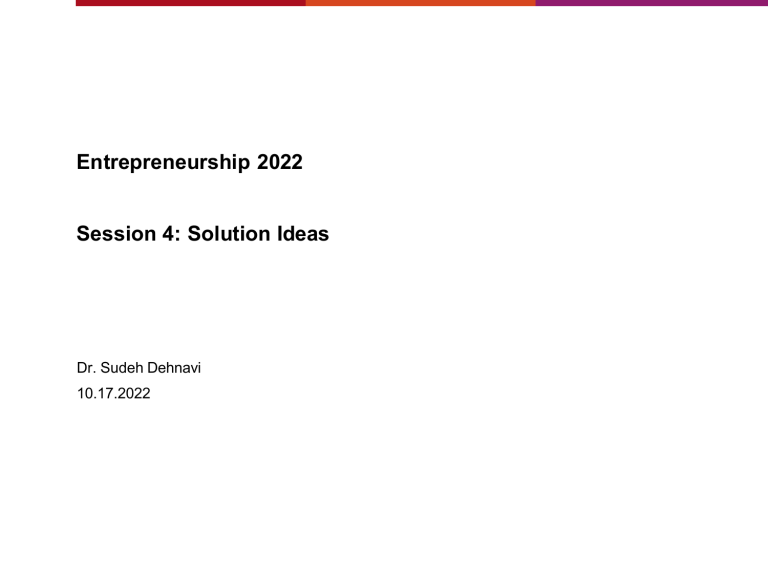
Entrepreneurship 2022 Session 4: Solution Ideas Dr. Sudeh Dehnavi 10.17.2022 Good Morning Who did at least one interview with a person potentially affected by the problem or involved in the problem? 2? 4? “If I had an hour to solve a problem I'd spend 55 minutes thinking about the problem and five minutes thinking about solutions.” Albert Einstein quality of the solution you generate is in direct proportion to your ability to identify the problem you hope to solve. Agenda for today • Problem Statement (15 min) • Innovation opportunities (15 min) • Exercise and group work: Tools to Develop Solution Ideas Part 1: rapid brainstorming (1 or 2 rounds of 40 min) • Break (15 min) • Exercise and group work: Tools to Develop Solution Ideas Part 2: clustering (10 min) • Exercise and group work: Tools to Develop Solution Ideas Part 3: evaluation (20 min) •User Segments and Value Proposition (15 min) Exercise: World of Intention (45 min) Problem statement How can (user) change or improve in order to (behavior/action/insight) ? (goal) Source: CEWAS Feed back for Problem statement (10 min) • Write the problem from the user perspective. While descovering the root problem, user may change. Is „in order to …“ a matter for the user or for you? • Be precise with the problem statement. Others should understand the problem by reading your sentence. Describe the user group, … • Focus on one behaviour/action/insight (to chage, reduce, improve) • Is it the problem to be addressed? Root problem? • Try to avoid imposing restrictions at this starge • Do not go for any potential solutions Problem Statement Example How can Tunisian animal farmers (cattle, goat,..) improve their continuous access to locally produced animal feed in order to ensure animal health and productivity while minimizing operational costs ? Source: CEWAS Innovation Opportunity Example - Produce feed with minimal inputs - Produce feed from waste inputs - Provide a logistic solution to feed producers - Provide technical or knowledge services to farmers for feed production Turning Challenges into Opportunities Discover and address markets needs. Understand the potential of challenges: Scarcity: makes a resource precious; opens avenues for alternative resources; makes effective supply chains more important Pollution: social pressure makes individual/public solutions necessary; can polluted be cleaned or reused? are pollutants resources? Source: CEWAS Factors that affect your innovation potential $ Market/user size Value offered Innovation/business strategy Competition Source: CEWAS Some sector challenges you research(ed) Source: CEWAS Where do opportunities for innovation lie? Medium-size innovative water & sanitation services & techs Biomass, Small Hydro Energy Recovery Water Stewardships, Integrity, Knowledge Management Wastewater Irrigation, Waste Nutrient Recovery Food-waste, Food processing Source: CEWAS Write down the innovation opportunities for your problem statement (5 min) 123- 4- Part 1: Developing your solution Part 2: Positioning and defining the value of your solution Part 3: Using innovation strategies to increase the value of your solution Source: CEWAS Part 1: Developing your solution Develop Solution Ideas in 3 Steps Rapid Brainstorming Collect as many solution ideas to your problem as possible Idea Clustering Create solution packages Evaluation of Idea Potential Value, Feasibility, Scalability, Creativity Step-by-step Rapid Brainstorming (40 min) 5 rounds of rapid barnstorming, each for 8 minutes Size of the group: 5 participants Brainstorming team: Problem owner Moderator Other participants Step-by-step Rapid Brainstorming (40 min) Step 0: Open the GoogleDoc file: https://docs.google.com/document/d/1sCu_ZpDtw8ZPDEoJ9ZXptnWrC9n7nUj8fsoUcyDdts/edit?usp=sharing Step 1: Problem owner: Ask the others if they have read and understood the problem statement and to clarify any questions that might arise Moderator: keep time (max 3 min) Step 2: All: use mentimeter to write down as many thoughts of ideas that each of you have. Moderator: keep time (exactly 5 min) • During this time do not discuss the issue and don’t talk. Just focus on whatever crosses your mind. • • Don’t limit the number of ideas – we want to maximize those. If you feel there was not enough time, you can come back to the mentimeter during the break. Step 4: Once you have finished this round, change to a new moderator and repeat the process. Develop Solution Ideas Rapid Brainstorming Collect as many solution ideas to your problem as possible Idea Clustering Create solution packages Evaluation of Idea Potential Value, Feasibility, Scalability, Creativity Clustring of Ideas Title of the cluster Title of a cluster Title of a cluster Title of a cluster Title of the solution package Title of the solution package Title of the solution package Title of the solution package Develop Solution Ideas Rapid Brainstorming Collect as many solution ideas to your problem as possible Idea Clustering Create solution packages Evaluation of Idea Potential Value, Feasibility, Scalability, Creativity Evaluation of Idea Potential Evaluation of Potential Idea Value 1 2 3 4 5 6 7 8 9 10 3 4 5 6 7 8 9 10 2 3 4 5 6 7 8 9 10 2 3 4 5 6 7 8 9 10 Feasibility 1 2 Scalability 1 Creativity 1 Strategies to create value with innovations FUNCTIONALITY instead of conventional approach UNDERSTAND desires, anxieties and jobs of USERS & CUSTOMERS create economies of SCALE assemble existing services and products into something new use what is abundantly available create more resources (RRR) shorten value chain (cut out middle men) make services or products CHEAPER Source: CEWAS What makes a solution innovative New REVENUE MODELS (e.g. subscriptions instead of sales ) New PRODUCT or product combinations Innovative PRODUCTION (to make products CHEAPER or BETTER) Innovative PARTNERSHIPS 26 ! Different SALES CHANNNELS (e.g. social media) New USER & CUSTOMER SEGMENTS Innovative CUSTOMER RELATIONSHIP Models (e.g. platforms) Source: CEWAS Part 2: Positioning and defining the value of your solution Who are your users? For whom are you creating value? Who are your most important users? Segment 1 Segment 2 Segment 3 Give your segment a name: Common characteristics of the segment? - Behaviour - Gender - Income - Values - Location - Needs - ………. Picture Segment: Your most ideal user Name: Age: Profession: Where does he/ she ........................ Fears: Goals: Challenges Values: Why does he/ she want to use/ buy your product/ service? What does he/ she like? What does he/ she dislike about your product/ service? Where oes he/ she see weaknesses or problems? Value Proposition of a Solution Unique value proposition (UVP): - Core benefit or solution Differentiates your product or service from the competition Positions your product or service as the best possible option on the market Value Proposition of a Solution What are your value propositions to your customer segments? - - - What added value do you deliver to the user? Which one of your users’ problems are you helping to solve? Which user needs are you satisfying? What bundle of products and services are you offering to each user segment? What is unique about your offer (compared to the competition)? Example of Value Propositions [My business] ‘s (products / services) help(s) (customers) who want to (jobs/tasks to be done) by . (own verb) Source: CEWAS Example of Value Propositions [My business] ‘s _organic waste treatment service produces insects (products / services) that_ help(s) poultry and meat farmers in the North of Jordan (customers) who want to _feed animal proteins_ by _ affordable and accessible (jobs/tasks to be done) (own verb) means. Source: CEWAS Part 3: Using innovation strategies to increase the value of your solution Business Model Canvas KEY ACTIVITIES KEY PARTNERS KEY RESOURCES COST STRUCTURE VALUE PROPOSITION CUSTOMER RELATIONSHIPS CHANNELS R E VE NUE STREAMS CUSTOMER SEGMENTS Where does Ideation stand in the Innovation Process? Source: CEWAS
